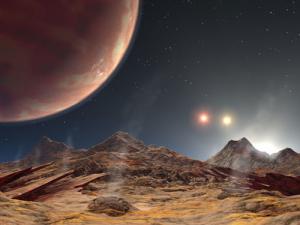The Spitzer Space Telescope has discovered planets forming around binary stars
 The image is drawn from the surface of a hypothetical moon orbiting the first known planet in a close triple system. The gas giant discovered by the KC-1 telescope on Mauna Kea in Hawaii closely orbits a single star that is also surrounded by a pair of hot stars.
The image is drawn from the surface of a hypothetical moon orbiting the first known planet in a close triple system. The gas giant discovered by the KC-1 telescope on Mauna Kea in Hawaii closely orbits a single star that is also surrounded by a pair of hot stars.
Astronomers who used the Spitzer Space Telescope to observe binary systems say that asteroid disks, comets, dust, and possibly planets, are at least as common there as around individual stars. Since more than half of the stars are members of binary star systems, the universe may be full of planets that have two suns. Sunsets like in the world of Luke Skywalker from Star Wars - Tatooine, where two suns set one after the other are not rare.
"There appears to be no bias toward solar systems around binary stars," says David Trilling of the University of Arizona in Tucson, lead researcher on the paper published in the April 1 issue of the Astrophysical Journal. According to him there are countless planets with two or more suns.
Previously, planets were discovered only around single suns or in wide double systems - systems where the distance between the suns was greater than a thousand astronomical units (an astronomical unit is 150 million km, the distance from the Earth to the Sun). Of the approximately 200 planets discovered, 50 orbit one of the members of a wide binary system.
Spitzer's new research looked at systems where the distance between the two stars ranges from zero to 500 YA. Until now, it was not known whether the proximity would affect the formation of the planets. Standard planet detection techniques do not work in such systems. It was not until 2005 that one candidate for a planet in a multi-star system was discovered.
Trilling and his colleagues observed double systems with Spitzer's infrared instruments and looked for the disc from which the planets will form. They observed systems where the stars were hotter and younger than our sun. The presence of the disk could lead to the formation of planets in the future.
In the in-depth study they examined 69 binary systems in the range between 50 and 200 light years. About 40% of them contained disks, a frequency higher than that of single stars. In addition, the astronomers were amazed to discover disks around 60% of the close binary star systems - those where the distance between the stars ranges from 0 to 3 AU. These are the systems whose planets have a Tatooine-like sunset. "We were surprised to find that dense systems have more disks," Trilling said. "This means that the planet formation process favors such systems over a single star, but it is also possible that binary systems are simply dustier. Future observations will decide.”
However, the study showed that in systems where the distance between the stars is 3-50 astronomical units there are few disks. It is possible that planets prefer near or distant suns, but not the in-between."
"Scientists have so far ignored double stars," says Trilling. "They are harder to study, but they may be the most common for planet formation in our galaxy."

4 תגובות
It's just amazing to discover how common my stars are
You walked in our galaxy or even just in our "neighborhood".
The invention of planets orbiting a dual system is instructive
For their inventions around almost every star.
And to think that we discovered only 200 of them…..
radiation*
Spitzer is supposed to explore the universe in the infrared range. The colder an object in space is, the more it emits kaina with a lower frequency. Spitzer observes objects that are too cold, too far away, and too hidden to be observed by other observatories. Whole areas of space are hidden behind huge clouds of dust. Scanning these areas in the infrared field eliminates the The dust clouds reveal what is hidden behind them. This ability led to the discovery of objects in space that cannot be distinguished. Its device is hidden in a cooling jacket of 95 gallons of liquid helium. ISA is about to launch its twin brother "Herschel" It was the most powerful telescope in its field and will be equipped with a 3.5 meter mirror that will pick up radiation at wavelengths in the sub-millimeter range. It will be launched in July 2007